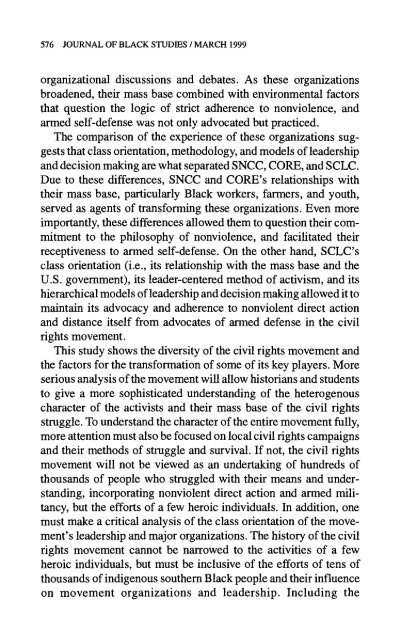MXGM Self-Defence Manual
MXGM Self-Defence Manual
MXGM Self-Defence Manual
Create successful ePaper yourself
Turn your PDF publications into a flip-book with our unique Google optimized e-Paper software.
576 JOURNAL OF BLACK STUDIES / MARCH 1999<br />
organizational discussions and debates. As these organizations<br />
broadened, their mass base combined with environmental factors<br />
that question the logic of strict adherence to nonviolence, and<br />
armed self-defense was not only advocated but practiced.<br />
The comparison of the experience of these organizations suggests<br />
that class orientation, methodology, and models of leadership<br />
and decision making are what separated SNCC, CORE, and SCLC.<br />
Due to these differences, SNCC and CORE's relationships with<br />
their mass base, particularly Black workers, farmers, and youth,<br />
served as agents of transforming these organizations. Even more<br />
importantly, these differences allowed them to question their commitment<br />
to the philosophy of nonviolence, and facilitated their<br />
receptiveness to armed self-defense. On the other hand, SCLC's<br />
class orientation (i.e., its relationship with the mass base and the<br />
U.S. government), its leader-centered method of activism, and its<br />
hierarchical models of leadership and decision making allowed it to<br />
maintain its advocacy and adherence to nonviolent direct action<br />
and distance itself from advocates of armed defense in the civil<br />
rights movement.<br />
This study shows the diversity of the civil rights movement and<br />
the factors for the transformation of some of its key players. More<br />
serious analysis of the movement will allow historians and students<br />
to give a more sophisticated understanding of the heterogenous<br />
character of the activists and their mass base of the civil rights<br />
struggle. To understand the character of the entire movement fully,<br />
more attention must also be focused on local civil rights campaigns<br />
and their methods of struggle and survival. If not, the civil rights<br />
movement will not be viewed as an undertaking of hundreds of<br />
thousands of people who struggled with their means and understanding,<br />
incorporating nonviolent direct action and armed militancy,<br />
but the efforts of a few heroic individuals. In addition, one<br />
must make a critical analysis of the class orientation of the movement's<br />
leadership and major organizations. The history of the civil<br />
rights movement cannot be narrowed to the activities of a few<br />
heroic individuals, but must be inclusive of the efforts of tens of<br />
thousands of indigenous southern Black people and their influence<br />
on movement organizations and leadership. Including the


